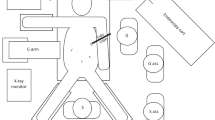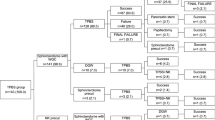Abstract
Background
Sphincter of Oddi dysfunction (SOD) is thought to be a cause of chronic abdominal pain post Roux-en-Y gastric bypass, and current practice of performing endoscopic retrograde cholangiopancreatography (ERCP) with or without sphincterotomy is not supported by evidence. In addition to the complexity and risks of the procedure in patients with Roux-en-Y anatomy, the outcomes are uncertain and debatable. We performed a retrospective review and analysis of post-gastric bypass patients who had undergone ERCP with sphincterotomy to determine the effectiveness in patients with suspected SOD.
Methods
Over a period of 5 years at the University of Minnesota, we retrospectively reviewed a prospectively collected database of a cohort of patients whom had a previous Roux-en-Y gastric bypass and whom had a subsequent ERCP for suspected SOD. Patients were categorized by modified Milwaukee classification, and outcomes were evaluated by patients’ self-reporting of symptoms at follow-up.
Results
We identified 50 patients who underwent laparoscopic-assisted gastrostomy for endoscopic retrograde cholangiopancreatography post Roux-en-Y gastric bypass over the study period. Within this group, 35 patients (70%) were suspected to have SOD. Nine patients (25.7%) were classified as type I, 19 patients (54.3%) type II, and seven patients (20%) type III. Thirty-four patients (97.1%) had biliary sphincterotomy, and 17 patients (48.6%) had both biliary and pancreatic sphincterotomy. Fourteen (40%) had repeated ERCP. At median follow-up of 11.5 months, type I SOD had two responders (25%), type II had nine responders (52.9%), and type III had one responder (14.3%). A subgroup analysis did not show significant differences in improvement of symptoms between patients whom had single versus repeated ERCP or biliary sphincterotomy alone versus both biliary and pancreatic sphincterotomy. Three patients (9%) had post-ERCP pancreatitis.
Conclusions
SOD in patients post Roux-en-Y gastric bypass is complex due to multiple confounding factors. Rome III and Milwaukee classification systems assist us in the diagnosis and treatment of sphincter dysfunction until we have a better way to predict treatment response post sphincterotomy. Current treatment is based on the type of disorder and anatomy of biliary ducts. Types I and II sphincter dysfunction particularly associated with dilated biliary duct on imaging have the best response to endoscopic sphincterotomy and therefore should be considered taking into account the risks and benefit. Repeated sphincterotomy and concurrent pancreatic sphincterotomy is generally not useful.





Similar content being viewed by others
References
Angrisani L, Santonicola A, Iovino P, et al. Bariatric surgery worldwide 2013. Obes Surg. 2015;25(10):1822–32.
Cho M, Kaidar-Person O, Szomstein S, et al. Emergency room visits after laparoscopic Roux-en-Y gastric bypass for morbid obesity. Surg Obes Relat Dis. 2008;4(2):104–9.
Saunders J, Ballantyne GH, Belsley S, et al. One-year readmission rates at a high volume bariatric surgery center: laparoscopic adjustable gastric banding, laparoscopic gastric bypass, and vertical banded gastroplasty-Roux-en-Y gastric bypass. Obes Surg. 2008;18(10):1233–40.
Kellogg TA, Swan T, Leslie DA, et al. Patterns of readmission and reoperation within 90 days after Roux-en-Y gastric bypass. Surg Obes Rel Dis. 2009;5(4):416–23.
Swartz DE, Mobley E, Felix EL. Bile reflux after Roux-en-Y gastric bypass: an unrecognized cause of postoperative pain. Surg Obes Relat Dis. 2009;5(1):27–30.
Bal B, Shope T, Finelli FC, et al. Pravalence and causes of abdominal pain following fully divided Roux-en-Y gastric bypass surgery. 2011;2:187.
Drossman DA, Li Z, Andruzzi E, et al. US householder survey of functional gastrointestinal disorders. Prevalence, sociodemographic, and health impact. Dig Dis Sci. 1993;38:1569–80.
Bar-Meir S, Halpern Z, Bardan E, et al. Frequency of papillary dysfunction among cholecystectomized patients. Hepatomogy. 1984;4:328–30.
Matlock J, Ikramuddin S, Lederer H, et al. Bypassing the bypass: ERCP via gastrostomy after bariatric surgery. GI Endo. 2005;61(5):98.
Gutierrez JM, Lederer H, Krook JC, et al. Surgical gastrostomy for pancreatobiliary and duodenal access following Roux-en-Y gastric bypass. J Gastrointest Surg. 2009;13:2170–5.
Drossman DA. Moderator. AGA clinical symposium—Rome III: new criteria for the functional GI disorders. Los Angeles: Program and abstracts of Digestive Disease Week; May 20–25; 2006.
Geenen JE, Hogan WJ, Dodds WJ, et al. The efficacy of endoscopic sphincterotomy after cholecystectomy in patients with sphichter of Oddi dysfunction. New Engl J Med. 1989;320:82–7.
Peterson BT. Sphincter of Oddi dysfunction, part 2: evidence based review of the presentations, with “objective” pancreatic findings (types I and II) and of presumptive type III. Gastrointest Endosc. 2004;59:670–86.
Cohen S, Bacon BR, Berlin JA, et al. National Institutes of Health state of the science conference statement: ERCP for diagnosis and therapy. Gastrointest Endosc. 2002;56:803–9.
Kalarchian MA, Marcus MD, Levine MD, et al. Psychiatric disorders among bariatric surgery candidates: relationship to obesity and functional health status. Am J Psychiatry. 2007;164:328–34.
Lin HY, Huang CK, Tai CM, et al. Psychiatric disorders of patients seeking obesity treatment. BMC Psychiatry. 2013;13:1.
Hayden MJ, Murphy KD, Brown WA, et al. Axis I disorders in adjustable gastric band patients: the relationship between psychopathology and weight loss. Obes Surg. 2014;24(9):1469–75.
Malik S, Mitchell JE, Engel S, et al. Psychopathology in bariatric surgery candidates: a review of studies using structured diagnostic interviews. Compr Psychiatry. 2014;55:248–59.
Vitton V, Delpy R, Lesavre N, et al. Is endoscopic sphincterotomy avoidable in patients with sphincter of Oddi dysfunction? Eur J Gastroenterol Hepatol. 2008;20(1):15–21.
Khuroo MS, Zargar SA, Yattoo GN. Efficacy of nifedipine therapy in patients with sphincter of Oddi dysfunction: a prospective, double-blind, randomized, placebo-controlled, cross over trial. Br J Clin Pharmacol. 1992;33(5):477–85.
Sand J, Nordback I, Koskinen M, et al. Nifedipine for suspected type II sphincter of Oddi dyskinesia. Am J Gastroenterol. 1993;88(4):530–5.
Hall TC, Dennison AR, Garcea G. The diagnosis and management of Sphincter of Oddi dysfunction: a systemic review. Langenbecks Arch Surg. 2012;397(6):889–98
Rolny P, Geenen JE, Hogan WJ. Post-cholecystectomy patients with “objective signs” of partial bile outflow obstruction: clinical characteristics, sphincter of Oddi manometry findings, and results of therapy. Gastrointest Endosc. 1993;39(6):778–81.
Thatcher BS, Sivak MV, Tedesco FJ, et al. Endoscopic sphincterotomy for suspected dysfunction of the sphincter of Oddi. Gastrointest Endosc. 1987;33(2):91–5.
Cotton PB, Durkalski V, Romagnuolo J, et al. Effect of endoscopic sphincterotomy for suspected sphincter of Oddi dysfunction on pain-related disability following cholecystectomy: the EPISODE randomized clinical trial. JAMA. 2014;311(1):2101–9.
Morgan KA, Glenn JB, Byrne K, et al. Sphincter of Oddi dysfunction after Roux-en-Y gastric bypass. Surg Obes Real Dis. 2009;5:571–5.
Freeman ML, Gill M, Overby C, et al. Predictors of outcomes after biliary and pancreatic sphincterotomy for sphincter of oddi dysfunction. J Clin Gastroenterol. 2007;41(1):94–102.
Grimes KL, Maciel VH, Mata W, et al. Complications of laparoscopic transgastric ERCP in patients with Roux-en-Y gastric bypass. Surg Endosc. 2015;29:1753–9.
Saleem A, Levy MJ, Petersen BT, et al. Laparoscopic assisted ERCP in Roux-en-Y gastric bypass (RYGB) surgery patients. J Gastrointest Surg. 2012;16(1):203–8.
Author information
Authors and Affiliations
Corresponding author
Ethics declarations
This study was approved by the respective Institutional Review Board of our center.
Conflict of Interest
The authors declare that they have no conflict of interests.
Informed Consent
Informed consent was obtained from all individual participants included in the study.
Rights and permissions
About this article
Cite this article
Lim, C.H., Jahansouz, C., Freeman, M.L. et al. Outcomes of Endoscopic Retrograde Cholangiopancreatography (ERCP) and Sphincterotomy for Suspected Sphincter of Oddi Dysfunction (SOD) Post Roux-En-Y Gastric Bypass. OBES SURG 27, 2656–2662 (2017). https://doi.org/10.1007/s11695-017-2696-4
Published:
Issue Date:
DOI: https://doi.org/10.1007/s11695-017-2696-4




